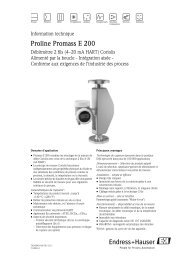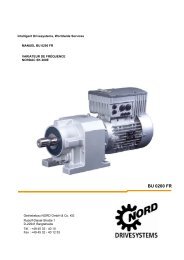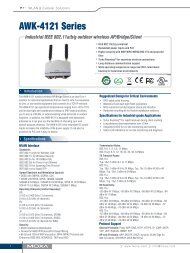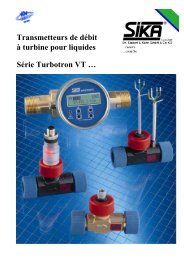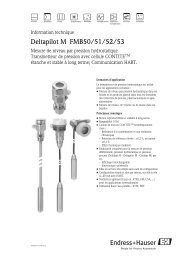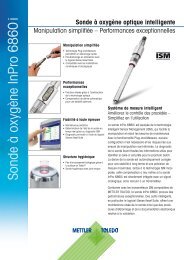2 Electronic safety sensors Sensor RSS 36 Ordering details ...
2 Electronic safety sensors Sensor RSS 36 Ordering details ...
2 Electronic safety sensors Sensor RSS 36 Ordering details ...
Create successful ePaper yourself
Turn your PDF publications into a flip-book with our unique Google optimized e-Paper software.
<strong>Electronic</strong> <strong>safety</strong> <strong>sensors</strong><br />
<strong>Sensor</strong> <strong>RSS</strong> <strong>36</strong><br />
9<br />
4,5<br />
6,2<br />
2<br />
• Thermoplastic enclosure<br />
• 2 short-circuit proof, p-type <strong>safety</strong> outputs<br />
(24 VDC per 250 mA)<br />
• Increased protection against tampering by<br />
optional individual coding of <strong>safety</strong> sensor<br />
and actuator<br />
• Optional version with latching available<br />
• Safety and diagnostic signals can be wired<br />
in series<br />
• Integral cross-wire, wire breakage and<br />
external voltage monitoring of the <strong>safety</strong><br />
cables up to the control cabinet<br />
• LED status indication<br />
• <strong>Sensor</strong> with connecting cable or<br />
with integrated connector<br />
• Robust due to the used cleaning<br />
agent-resistant materials and protection<br />
class up to IP69K<br />
Approvals<br />
106<br />
91<br />
74<br />
78<br />
F *<br />
* under preparation<br />
<strong>Ordering</strong> <strong>details</strong><br />
<strong>RSS</strong> <strong>36</strong> ➀-➁-➂-➃<br />
No. Option Description<br />
18.5<br />
25<br />
M12<br />
22<br />
➀<br />
Standard coding<br />
I1 Individual coding<br />
I2 Individual coding, unlimited<br />
➁ D With diagnostic output<br />
SD With serial diagnostic<br />
➂<br />
Without latching<br />
R with latching,<br />
latching force approx. 18 N<br />
➃<br />
With connecting cable 2 m<br />
ST With integrated connector M12<br />
Actuator, sealing kit and tamper-proof screws<br />
must be ordered separately.<br />
Actuator RST <strong>36</strong>-1<br />
25<br />
22<br />
• Thermoplastic enclosure<br />
• Flexible fitting through universal<br />
mounting holes<br />
Approvals<br />
F<br />
<strong>Ordering</strong> <strong>details</strong><br />
Certification in combination<br />
with <strong>safety</strong> sensor<br />
Actuator RST <strong>36</strong>-1<br />
Actuator, with latching magnet RST <strong>36</strong>-1-R<br />
(The latching function is only active when<br />
<strong>RSS</strong> <strong>36</strong>-…R is combined with RST <strong>36</strong>-1-R.)<br />
91<br />
78<br />
Technical data<br />
Standards: IEC 60947-5-3, EN ISO 13849-1,<br />
IEC 61508<br />
Enclosure:<br />
glass-fibre reinforced<br />
thermoplastic<br />
Mode of operation:<br />
RFID<br />
Actuator:<br />
RST <strong>36</strong>-1, RST <strong>36</strong>-1-R<br />
Series-wiring:<br />
unlimited number of<br />
components, however <strong>safety</strong>-dependent;<br />
max. 31 components for serial diagnosis<br />
Connection: Integrated connector M12<br />
or connecting cable<br />
- Integrated connector: M12, 8-pole, A-coded<br />
- Connecting cable: Y-UL 2517 / 8 x AWG 22 /<br />
8 x 0.35 mm², 2 m<br />
Temperature resistance of the cable:<br />
- At rest: −30 °C … +105 °C<br />
- In movement: −10 °C … +105 °C<br />
Cable length:<br />
max. 30 m<br />
(Cable length and cable section alter the<br />
voltage drop depending on the output current)<br />
Switching distances to IEC 60947-5-3:<br />
Rates switching distance S n :<br />
12 mm<br />
Assured switch-on point S ao :<br />
10 mm<br />
Assured switch-off point S ar :<br />
16 mm<br />
Hysteresis:<br />
< 2,0 mm<br />
Repeat accuracy:<br />
< 0.5 mm<br />
Ambient conditions:<br />
Ambient temperature Tu: −25 °C … +70 °C<br />
Storage and transport<br />
temperature: −25 °C … +85 °C<br />
Protection class: IP65 / IP67 to EN 60529;<br />
- Connector: IP69K to DIN 40050-9<br />
Resistance to vibration:<br />
10…55 Hz,<br />
amplitude 1 mm<br />
Resistance to shock:<br />
30 g / 11 ms<br />
Switching frequency f:<br />
1 Hz<br />
Response time:<br />
≤ 100 ms<br />
Duration of risk:<br />
≤ 200 ms<br />
Standby delay:<br />
≤ 5 s<br />
Electrical data:<br />
Rated operating<br />
voltage U e : 24 VDC -15% / +10%<br />
(PELV)<br />
Rated operating current I e :<br />
0,6 A<br />
Lowest operating current I m :<br />
0,5 mA<br />
Required rated short-circuit current: 100 A<br />
Rated insulation voltage U i :<br />
32 V<br />
Note<br />
Additional information:<br />
SD Gateway Page 1-144<br />
Series-wiring accessories Page 1-146<br />
Wiring Page 1-143<br />
Connector Page 1-143<br />
Diagnostic tables Page A-3<br />
Suitable <strong>safety</strong> monitoring modules Page 5-2<br />
2
<strong>Electronic</strong> <strong>safety</strong> <strong>sensors</strong><br />
Technical data<br />
Rated impulse withstand<br />
voltage U imp :<br />
800 V<br />
No-load current I 0 :<br />
35 mA<br />
Protection class:<br />
II<br />
Overvoltage category:<br />
III<br />
Degree of pollution: 3<br />
Safety inputs X1/X2:<br />
p-type,<br />
short-circuit proof<br />
Rated operating<br />
voltage U e1 : 24 VDC -15% / +10%<br />
(PELV to IEC 60204-1)<br />
Current consumption per input: 5 mA<br />
Safety outputs Y1/Y2:<br />
p-type,<br />
short-circuit proof<br />
Rated operating current I e1 : max. 0,25 A<br />
Utilisation category: DC-12: U e /I e : 24 VDC/0,25 A<br />
<br />
DC-13: U e /I e : 24 VDC/0,25 A<br />
Voltage drop: < 1 V<br />
Diagnostic output:<br />
p-type,<br />
short-circuit proof<br />
Rated operating current I e2 : max. 0,05 A<br />
Utilisation category: DC-12: U e /I e : 24 VDC/0,05 A<br />
<br />
DC-13: U e /I e : 24 VDC/0,05 A<br />
Voltage drop: < 2 V<br />
Serial diagnostic: short-circuit proof<br />
Operating current:<br />
150 mA<br />
Wiring capacitance for<br />
serial diagnostic:<br />
max. 50 nF<br />
External cable protection:<br />
Fuse<br />
- Integrated connector: 2,0 A<br />
- Connecting cable: 4,0 A<br />
Please observe the cable<br />
section of the lead-on cable<br />
LED functions:<br />
Green<br />
Supply voltage on<br />
Yellow<br />
Operating status<br />
Red<br />
Error<br />
Classification:<br />
Standards: EN ISO 13849-1, IEC 61508,<br />
IEC 62061, IEC 60947-5-3<br />
PL:<br />
up to e<br />
Category: up to 4<br />
SIL:<br />
suitable for SIL 3 applications<br />
Mission time:<br />
20 years<br />
Classification:<br />
PDF-M<br />
Note<br />
Requirements for the <strong>safety</strong> controller<br />
Dual-channel <strong>safety</strong> input, suitable for p-type<br />
<strong>sensors</strong> with normally-open (NO) function.<br />
The internal function tests of the <strong>sensors</strong><br />
cause the outputs to cyclically switch off for<br />
max. 0.25 ms, this must be tolerated by the<br />
<strong>safety</strong> controller. The <strong>safety</strong> controller must<br />
not be equipped with cross-wire detection.<br />
Detailed information about the use of the serial<br />
diagnostics can be found in the operating instructions<br />
of the PROFIBUS-Gateway SD-I-DP-<br />
V0-2 and the Universal-Gateway SD-I-U-….<br />
A detailed product description can be found in<br />
the „<strong>Electronic</strong> Safety <strong>Sensor</strong>s and Solenoid<br />
Interlocks“ brochure.<br />
Misalignment<br />
Lateral actuation<br />
Y<br />
X<br />
The axial misalignment (Y) is max. ± 18 mm.<br />
The height misalignment (X) is max. ± 8 mm.<br />
Latching versions X ± 5 mm, Y ± 3 mm.<br />
The latching force is reduced by misalignment.<br />
Actuating curves<br />
The actuating curves (S) represent the typical<br />
switching distance of the <strong>safety</strong> sensor during<br />
the approach of the actuator subject to the<br />
actuating direction.<br />
Transverse misalignment<br />
S [mm] 12<br />
10<br />
5<br />
0<br />
-20 -15 -10 -5 0 5 10 15 20<br />
Y[mm]<br />
Height misalignment<br />
S [mm]<br />
12<br />
10<br />
5<br />
0<br />
-24 -20 -15 -10 -5 0 5 10 15 20 24<br />
X[mm]<br />
Preferred actuating directions:<br />
from front or from side<br />
Coding procedure<br />
<strong>Ordering</strong> option -I1:<br />
During the individual coding, a RST actuator is<br />
taught by a simple routine during the start-up<br />
procedure, so that every form of tampering by<br />
means of a replacement or substitute actuator<br />
is permanently excluded.<br />
<strong>Ordering</strong> option -I2:<br />
Teaching the individual coding of a RST<br />
actuator by a simple routine during the start-up<br />
procedure (as -I1). A protected coding process<br />
enables the teaching of a new actuator for<br />
service purposes.<br />
System components<br />
Sealing kit<br />
<strong>Ordering</strong> <strong>details</strong><br />
Sealing kit ACC <strong>RSS</strong> <strong>36</strong>-SK 1215048<br />
for sealing the mounting holes and as<br />
spacer (approx. 3 mm) to facilitate the<br />
cleaning below the mounting surface<br />
(also suitable as tampering protection<br />
for the screw fastening)<br />
Tamperproof screws<br />
(not displayed)<br />
<br />
NRS M4X25-FHS<br />
NRS M4X30-FHS<br />
3
Diagnostic tables<br />
Diagnostic of the <strong>RSS</strong> <strong>36</strong> <strong>safety</strong> sensor with conventional diagnostic output<br />
The short-circuit proof diagnostic output OUT can be used for central visualisation or control functions, e.g. in a PLC. It indicates the switching condition<br />
as shown in the table. The diagnostic output can also be used to detect clearance variations between the sensor and the actuator in the same<br />
way as the yellow LED. This signal combination, diagnostic output disabled and <strong>safety</strong> channels still enabled, can be used to stop the production<br />
process in a controlled manner.<br />
A cross-wire or any failure that does notimmediately affect the <strong>safety</strong> function of the <strong>safety</strong> sensor, will lead to a delayed shutdown. In this case, the<br />
<strong>safety</strong> outputs are disabled after 30 minutes if the fault is not eliminated. The diagnostic output however is immediately disabled.<br />
The <strong>safety</strong> sensor indicates the operating condition and faults by means of three-colour LED‘s located in the lateral surfaces of the sensor.<br />
If the actuator is near the limit of the sensor’s switching distance, the LED will flash. The flash code can be used to prematurely detect changes in<br />
the distance between the sensor and the actuator (e.g. sagging of a guard door). The sensor must be adjusted before the distance to the actuator<br />
increases and before the <strong>safety</strong> outputs are disabled, thus stopping the machine. If an error is detected, the red LED will be activated.<br />
LED (red) Flash codes Cause<br />
1 flash pulse Error output Y1<br />
2 flash pulses Error output Y2<br />
3 flash pulses Cross-wire Y1/Y2<br />
4 flash pulses Ambient temperature too high<br />
5 flash pulses Incorrect or defective actuator<br />
Continuous red<br />
Internal device error<br />
Example of the diagnostic function of the <strong>safety</strong> sensor with conventional diagnostic output<br />
<strong>Sensor</strong> function LED`s Diagnostic output Safety outputs Note<br />
Green Red Yellow Y1, Y2<br />
I. Supply voltage on off off 0 V 0 V Voltage on, no evaluation of the<br />
voltage quality<br />
II. Actuated off off on 24 V 24 V The yellow LED always signals the<br />
presence of an actuator within range<br />
III. Actuated in limit area off off flashes<br />
(1Hz)<br />
24 V<br />
pulsed<br />
24 V The sensor must be adjusted before<br />
the distance to the actuator increases<br />
and before the <strong>safety</strong> outputs are<br />
disabled, thus stopping the machine<br />
IV. Error warning,<br />
off flashes off 0 V 24 V After 30 minutes → error<br />
sensor actuated<br />
V. Error off flashes off 0 V 0 V Refer to table with flash codes<br />
4A-3
Diagnostic tables<br />
Diagnostic of the <strong>RSS</strong> <strong>36</strong> <strong>safety</strong> sensor with serial diagnostic function<br />
<strong>Sensor</strong>s with serial diagnostic cable have a serial input and output cable instead of the conventional diagnostic output.<br />
If <strong>RSS</strong>/CSS <strong>sensors</strong> are daisy-chained, the <strong>safety</strong> outputs as well as the inputs and outputs of the diagnostic channels are wired in series.<br />
Max. 31 <strong>safety</strong> <strong>sensors</strong> can be wired in series. For the evaluation of the serial diagnostic cable, either the PROFIBUS-Gateway SD-I-DP-V0-2 or the<br />
Universal Gateway SD-I-U-... are used. This serial diagnostic interface is integrated as slave in an existing field bus system. In this way, the diagnostic<br />
signals can be evaluated by means of a PLC. The necessary software for the integration of the SD-Gateway is available for download at www.<br />
schmersal.com.<br />
The operational information of the responseand diagnostic data is automatically andpermanently written in an input byte of the PLC for each <strong>safety</strong> sensor<br />
in the series-wiredchain. The request data for each <strong>safety</strong> sensorare transmitted to the component through anoutput byte of the PLC.<br />
In the event of a communication error between the SD-Gateway and the <strong>safety</strong> sensor, the switching condition of the <strong>safety</strong> output of the <strong>safety</strong><br />
sensor is maintained.<br />
Failure<br />
A failure has occurred, which resulted in theimmediate deactivation of the <strong>safety</strong> outputs.The failure is reset when the failure cause iseliminated and bit 7 of<br />
the request bytechanges from 1 to 0 or when the <strong>safety</strong>guard is opened.Failures at the <strong>safety</strong> outputs will only bedeleted upon the next release, as<br />
theneutralisation of the failure cannot bedetected earlier.<br />
Failure warning<br />
A failure has occurred, which will disable the <strong>safety</strong> outputs after 30 minutes. The <strong>safety</strong> outputs initially remain enabled in order to enable a controlled<br />
shutdown of the process and set the machine safely to a hold position. A failure warning is reset when the failure cause is eliminated.<br />
Tabular overview of status signals, warnings or error messages<br />
Communication directions: Request byte: from the PLC to the local electronic <strong>safety</strong> switchgear<br />
Response byte: from the local electronic <strong>safety</strong> switchgear to the PLC<br />
Warning/error byte: from the local electronic <strong>safety</strong> switchgear to the PLC<br />
Bit n° Request byte Response byte Diagnostic<br />
Error warnings<br />
Error messages<br />
Bit 0: Error reset Safety output<br />
Error output Y1<br />
Error output Y1<br />
activated<br />
Bit 1: — Actuator detected Error output Y2 Error output Y2<br />
Bit 2: — — Cross-wire Y1/Y2 Cross-wire Y1/Y2<br />
Bit 3: — — Temperature too high Temperature too high<br />
Bit 4: — Input condition X1 and X2 — Wrong or defective<br />
actuator<br />
Bit 5: — Actuated in limit area Internal device error Internal device error<br />
Bit 6: — Error warning Communication error<br />
—<br />
between the field bus Gateway<br />
and the <strong>safety</strong> switch<br />
Bit 7: Error reset Error<br />
(enabling path switched off)<br />
— —<br />
The described condition is obtained, when bit = 1<br />
Function of the visual diagnostic LED`s, the serial status signals and the <strong>safety</strong> outputs by means of an example<br />
System condition LED`s Safety outputs<br />
Y1, Y2<br />
Status signals serial<br />
diagnostic byte Bit n°<br />
green red yellow 7 6 5 4 3 2 1 0<br />
Not actuated, inputs X1 and X2 enabled on off off 0 V 0 0 0 1 0 0 0 0<br />
Actuated, <strong>safety</strong> outputs enabled off off on 24 V 0 0 0 1 0 0 1 1<br />
Actuated in limit area off off flashes<br />
24 V 0 0 1 1 0 0 1 1<br />
(1Hz)<br />
Actuated, warning off on/flashes off 24 V 0 1 0 1 0 0 1 1<br />
Actuated, fault off on/flashes off 0 V 1 1 0 1 0 0 1 0<br />
The shown bit order of the diagnostic byte is an example. A different combination of the operational conditions will lead<br />
to a change of the bit order.<br />
A-45





